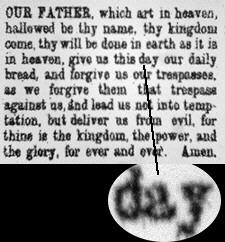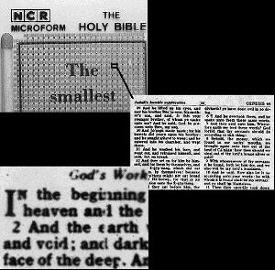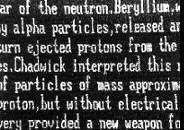HOW SMALL CAN YOU WRITE?
A brief look at some aspects of the history of reproducing small text
-
from microphotographs to moving atoms
by Dave Walker
As youngsters we have all probably tried to see how
small we could write our name or a message to a school-mate. Maybe the
quest was pushed to the limit by using the finest pen-nib we could find.
But how small can we reproduce text using the techniques scientists have
developed over the last century?
This article illustrates the following techniques:
- 19th century microphotography to display an image
of the Lord's Prayer on this sized dot '.'
- the modern use of microfiche to print the entire
Holy Bible on an area little more than the size of a postage stamp
- using electron beams to 'write' on surfaces, and
capable of putting a 29 volume Encyclopaedia on a pin-head
- and the ultimate in microwriting, write your name
with individual atoms!
The 19th century microscopists in Victorian England didn't
'miss a trick' when the new technique of photography was announced. Soon
after the silver halide based photographic emulsion had been developed,
these microscopists had started to use their microscopes to produce microphotographs
ie tiny photographs on a microscope slide.
It's a neat idea .... if you can use a microscope to magnify
tiny objects so that the eye could observe them, why not use the optics
of the microscope in reverse to project an image of say a painting through
the microscope to create a tiny image on a microscope slide. If the slide
had been pre-treated with photographic emulsion and developed like a photograph,
'hey presto' you have a permanent microphotograph of the painting which
can only be viewed under a microscope. What better novelty to impress your
friends with at the next meeting of amateur microscopists ... and this
is exactly what many of the early microphotographic slides were used for,
as microscopy was a popular past-time with Victorian 'society'.
The Victorian microscopist's used this technique to prepare
a wide variety of photomicrographs including works of art, portraits of
famous people and landscapes. To ensure the final image on the slide was
a 'positive' the usual technique was to take a normal photograph of the
subject and shine light through the developed negative, a glass plate in
those days, down the microscope to create a 'positive' image on the slide,
which was typically 1mm square.
The image of the Lord's prayer below is an example of
microphotography to miniaturise text. The block of text is 0.38 x 0.28
mm in size on the original microscope slide and therefore the entire text
could comfortably fit on the full stop at the end of this sentence. A microscope
at about 40x magnification is required to read the microphotograph.
 The text on the slide is 13 - 25 microns in height, so if the original
text was 2 mm high, the linear reduction of the text achieved in the microphotograph
is approximately 150:1. At the highest magnifications the individual silver
grains which make up the image can be seen, and they are typically 0.8
um across. The finer the silver grains the early microscopists were able
to achieve the higher the quality of the final image.
The text on the slide is 13 - 25 microns in height, so if the original
text was 2 mm high, the linear reduction of the text achieved in the microphotograph
is approximately 150:1. At the highest magnifications the individual silver
grains which make up the image can be seen, and they are typically 0.8
um across. The finer the silver grains the early microscopists were able
to achieve the higher the quality of the final image.
In the twentieth century the technique
of microphotography was developed for the storage of photo-reduced text
and images on microfilm and microfiche.
The reproduction of printed text in a greatly reduced form on film is called
microform. When the copying medium used is sheet rather than roll film
it is termed microfiche and each sheet usually has a readable legend on
the sheet for cataloguing.
 An example of the capabilities of modern microfiche is shown on the right.
It was produced by The NCR Corporation using their 'PCMI® Microform'
technique. The block of text on the sheet of film is 33x33 mm in size and
contains the entire 1,245 pages of the 'Holy Bible'! The match head shown
on the left of the microfiche gives a sense of scale. The text can be read
comfortably under a microscope at about 100x. Each page of double column
text is about 0.5 mm wide and 1 mm high (shown in the first blow-up). Each
text character is 8 um high (ie 8/1000ths of a millimetre). NCR note on
the paper wallet which the microform comes in, that this is a linear reduction
of about 250:1 or an area reduction of 62,500:1. (This would correspond
to the original text being ca. 2 mm high).
An example of the capabilities of modern microfiche is shown on the right.
It was produced by The NCR Corporation using their 'PCMI® Microform'
technique. The block of text on the sheet of film is 33x33 mm in size and
contains the entire 1,245 pages of the 'Holy Bible'! The match head shown
on the left of the microfiche gives a sense of scale. The text can be read
comfortably under a microscope at about 100x. Each page of double column
text is about 0.5 mm wide and 1 mm high (shown in the first blow-up). Each
text character is 8 um high (ie 8/1000ths of a millimetre). NCR note on
the paper wallet which the microform comes in, that this is a linear reduction
of about 250:1 or an area reduction of 62,500:1. (This would correspond
to the original text being ca. 2 mm high).
To put this into perspective, NCR also note in the accompanying
leaflet with the microfiche, that if this
reduction was used on the millions of books on the 270+ miles of shelving
in the Library of Congress, then the library could be stored in six standard
filing cabinets.
(Note: I have been asked if these bibles are still
available - I'm afraid I don't know.)
Microform is still widely used. In the author's local
library for example, many of the catalogues are folders of loose microfiches,
and the past issues of local newspapers are accessible as microfilm cartridges
which can be magnified, read on a screen and selections printed out if
desired. However, the increasingly widespread use of digital information
storage with its inherent benefits may eventually supersede the use of
microform.
The use of photographic reduction techniques is also widely
used in photolithography during the production of integrated circuits on
computer 'chips'. The etching and coating stages used to build up the complex
three dimensional structure of an integrated circuit is accomplished by
shining light through photomasks which act as miniature stencils. Where
the mask allows light to shine through, chemicals can etch the exposed
area or semiconductor material can be deposited.
Scientists have found that they have almost pushed the
capabilities of photoreduction to the limit for computer chip manufacture,
because the ultimate linear reduction achievable, which is about 1 micron,
is restricted by the wavelength of light used. Recently electron beams
are being used instead of ultra-violet light to project the images through
the photomask to produce the integrated circuit. This will allow much greater
circuit densities to be achieved on the microchip.
 Scientists are also experimenting with the use of an intense electron beam
to write patterns directly onto inorganic surfaces. This process called
SCRIBE (Sub-nanometre Cutting and Ruling with an Intense Beam of Electrons)
can make lines of only 1 nanometre wide (ie one millionth of a millimetre).
Using this technique it would be possible to write the entire contents
of the 29 volume Encyclopaedia Britannica on a pin-head! A small section
of the original text from the Encyclopaedia reproduced onto a film of aluminium
fluoride is shown on the right. Each text character is approximately 0.03
micron high, compared with microfiche characters above which are 8 micron
high.
Scientists are also experimenting with the use of an intense electron beam
to write patterns directly onto inorganic surfaces. This process called
SCRIBE (Sub-nanometre Cutting and Ruling with an Intense Beam of Electrons)
can make lines of only 1 nanometre wide (ie one millionth of a millimetre).
Using this technique it would be possible to write the entire contents
of the 29 volume Encyclopaedia Britannica on a pin-head! A small section
of the original text from the Encyclopaedia reproduced onto a film of aluminium
fluoride is shown on the right. Each text character is approximately 0.03
micron high, compared with microfiche characters above which are 8 micron
high.
But the ultimate in minute text must be the manipulation
of individual atoms to create text with characters tens of atoms across.
A famous example of 'atomic writing' created by IBM scientists at their Almaden Research Centre. The letters 'IBM' were created by positioning
xenon atoms on a nickel surface using a special scanning tunnelling microscope.
The letters are each about 6 nanometres across, which is close to the ultimate
in microwriting.
IBM researchers have also created a magnificent image
of Japanese characters by the manipulation of atoms,
Manipulation of individual atoms may seem just a scientific
curiousity but the development of such techniques may allow significant
advances in the fabrication of very high density computer chips. Also the
manipulation of atoms and molecules to build micro-machines is the basis
of the rapidly developing field of nanotechnology. Experts predict that
in the next century nanotechnology will be the basis for how we manufacture
complex miniature devices, treat disease and even explore the universe
..... the microscopic world around us and the technology we are developing
to control this scale of nature gets more exciting every day!
Picture credits and Web sites to visit
The microphotograph image of the Lord's Prayer was sourced
from a microscope slide distributed by the Postal Microscopical Society,
UK.
The electron beam lithograph image is credited to the
Department of Materials Science and Engineering, University of Liverpool,
UK.
A wide selection of Web sites providing details of electron
beam lithography and scanning tunnelling microscopy (STM) and the related
atomic force microscopy (AFM) can be found by an appropriate keywords with a Google search.
Further Reading
Read a Micscape
Web article by Roy Winsby on John Dancer, a pioneer of the production
of microphotographs.
Read a recent Micscape article
by Roy Winsby which describes the microphotograph slides of Dancer and
Suter in more detail.
1) Micrography - The Making of Microscopic Size Photographs
by N G Groom. Microscopy, 1986, 35 (6), pp.445-450. A modern practical
guide to making microphotographs on microscope slides.
2) Diamond Writing, 1853-1946 by B Bracegirdle
and S E Warren. Quekett J. Microscopy, 1996, 37, (part 8), pp. 621 - 632.
A fascinating historical summary of the men and machines producing microscopic
writing.
Microscopy, now the Quekett Journal of Microscopy,
is the Journal of the Quekett
Microscopical Club, a club for amateurs and professionals worldwide.
Comments to the author David
Walker email - pennine56 AT yahoo DOT co DOT uk. (The author is an amateur microscopist with a
casual interest in small writing).
February 23rd 2025. All the original web links now fail and have been revised.
© Microscopy UK or their contributors.
Please report any Web problems or offer general comments
to the Micscape
Editor,
via the contact on current Micscape Index.
Micscape is the on-line monthly magazine of the Microscopy
UK web
site at Microscopy-UK
WIDTH=1
© Onview.net Ltd, Microscopy-UK, and all contributors 1995 onwards. All rights
reserved. Main site is at www.microscopy-uk.org.uk with full mirror at www.microscopy-uk.net.
 The text on the slide is 13 - 25 microns in height, so if the original
text was 2 mm high, the linear reduction of the text achieved in the microphotograph
is approximately 150:1. At the highest magnifications the individual silver
grains which make up the image can be seen, and they are typically 0.8
um across. The finer the silver grains the early microscopists were able
to achieve the higher the quality of the final image.
The text on the slide is 13 - 25 microns in height, so if the original
text was 2 mm high, the linear reduction of the text achieved in the microphotograph
is approximately 150:1. At the highest magnifications the individual silver
grains which make up the image can be seen, and they are typically 0.8
um across. The finer the silver grains the early microscopists were able
to achieve the higher the quality of the final image.
 An example of the capabilities of modern microfiche is shown on the right.
It was produced by The NCR Corporation using their 'PCMI® Microform'
technique. The block of text on the sheet of film is 33x33 mm in size and
contains the entire 1,245 pages of the 'Holy Bible'! The match head shown
on the left of the microfiche gives a sense of scale. The text can be read
comfortably under a microscope at about 100x. Each page of double column
text is about 0.5 mm wide and 1 mm high (shown in the first blow-up). Each
text character is 8 um high (ie 8/1000ths of a millimetre). NCR note on
the paper wallet which the microform comes in, that this is a linear reduction
of about 250:1 or an area reduction of 62,500:1. (This would correspond
to the original text being ca. 2 mm high).
An example of the capabilities of modern microfiche is shown on the right.
It was produced by The NCR Corporation using their 'PCMI® Microform'
technique. The block of text on the sheet of film is 33x33 mm in size and
contains the entire 1,245 pages of the 'Holy Bible'! The match head shown
on the left of the microfiche gives a sense of scale. The text can be read
comfortably under a microscope at about 100x. Each page of double column
text is about 0.5 mm wide and 1 mm high (shown in the first blow-up). Each
text character is 8 um high (ie 8/1000ths of a millimetre). NCR note on
the paper wallet which the microform comes in, that this is a linear reduction
of about 250:1 or an area reduction of 62,500:1. (This would correspond
to the original text being ca. 2 mm high).
 Scientists are also experimenting with the use of an intense electron beam
to write patterns directly onto inorganic surfaces. This process called
SCRIBE (Sub-nanometre Cutting and Ruling with an Intense Beam of Electrons)
can make lines of only 1 nanometre wide (ie one millionth of a millimetre).
Using this technique it would be possible to write the entire contents
of the 29 volume Encyclopaedia Britannica on a pin-head! A small section
of the original text from the Encyclopaedia reproduced onto a film of aluminium
fluoride is shown on the right. Each text character is approximately 0.03
micron high, compared with microfiche characters above which are 8 micron
high.
Scientists are also experimenting with the use of an intense electron beam
to write patterns directly onto inorganic surfaces. This process called
SCRIBE (Sub-nanometre Cutting and Ruling with an Intense Beam of Electrons)
can make lines of only 1 nanometre wide (ie one millionth of a millimetre).
Using this technique it would be possible to write the entire contents
of the 29 volume Encyclopaedia Britannica on a pin-head! A small section
of the original text from the Encyclopaedia reproduced onto a film of aluminium
fluoride is shown on the right. Each text character is approximately 0.03
micron high, compared with microfiche characters above which are 8 micron
high.